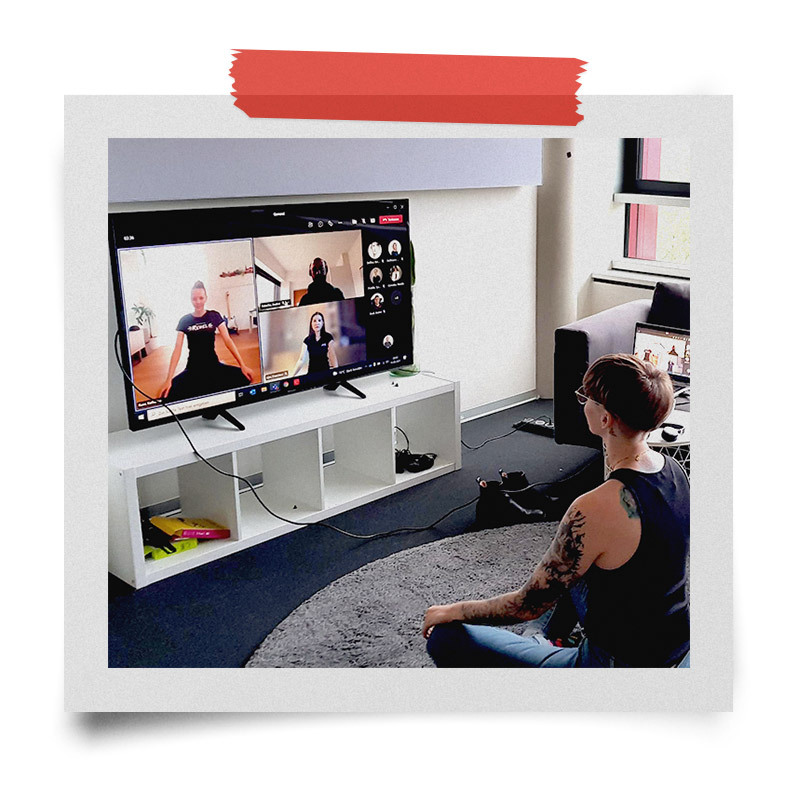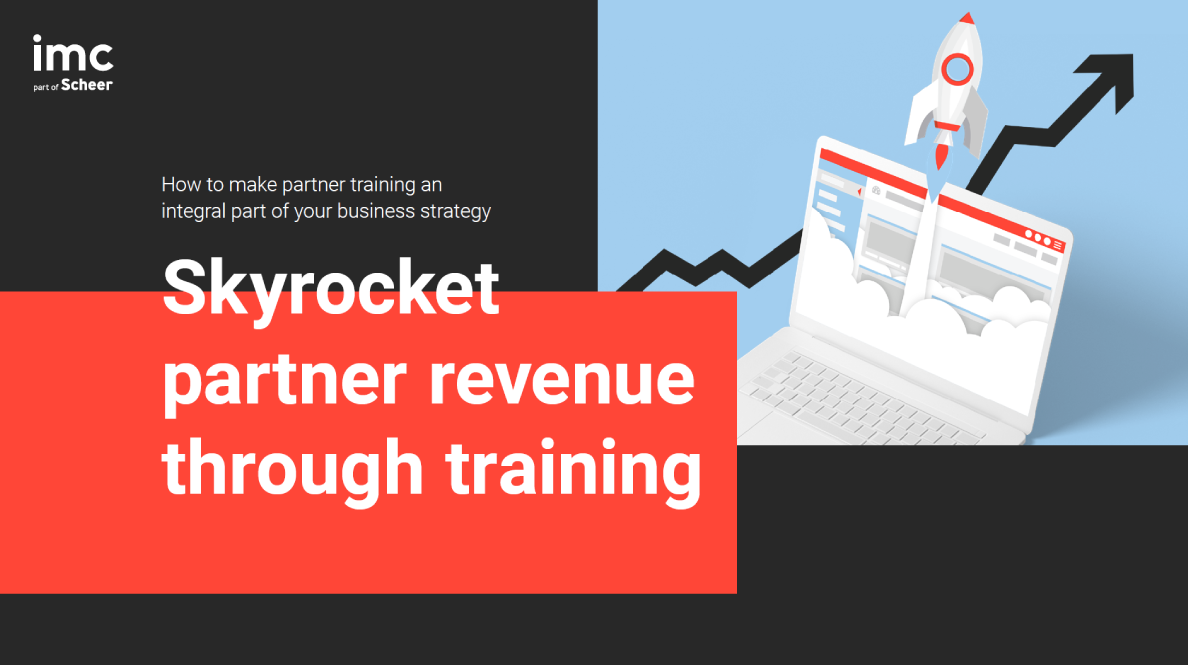
Training Digitisation – Leverage knowledge sharing among your people
Here we look at the important topics of knowledge sharing and training digitisation, with tips on how to leverage the experience of your employees to improve performance and future-proof your business.
For many businesses, especially those within the knowledge-based economy, existing employees are their greatest asset. Staff turnover is expensive for any business. Studies show that the direct cost of replacement is over £30,000 on average to replace an employee earning over £25,000 per annum. However, more detrimental is often the indirect cost that comes with losing valuable knowledge and experience - something that is far harder to measure.
Facilitating and encouraging knowledge sharing across your organisation can be an extremely effective way to both enhance productivity within your existing teams and mitigate the brain drain that comes with staff turnover.
While your L&D department can roll out training programmes in a planned and centralised manner, a culture of knowledge sharing and a toolkit that makes it easy means that information can be shared at the speed of need (‘Just in Time Learning’) and when it’s convenient for subject matter experts to do so.

Knowledge Sharing Definition
Knowledge sharing is the exchange of information, skills and experience between individuals or across groups. When expertise is shared by an experienced person, it allows further people to benefit from that experience in order to boost their own performance and that of their peers, potentially strengthening an entire organisation.
Much knowledge sharing occurs naturally and accidentally through day to day interactions and conversations - those ‘water-cooler’ moments that characterise informal learning or tacit knowledge. Of course, the Covid-19 pandemic has caused (or at least accelerated) the transition to a hybrid or fully-remote work environment, making the accidental water-cooler conversation much less likely for many.
That informal kind of knowledge transfer is a social activity that is often hard to describe and organise - it comes with nuance, intuition and the free-flow of ideas.
However, explicit knowledge is something that can be more planned for and organised, so that specific information can be codified and made available to others.
The main attributes of explicit knowledge sharing are:
- Describable - the subject matter expert must be able to clearly articulate the information and experience they want to share
- Visible - the recipient must be made aware that the learning materials exist
- Accessible - the recipient must be able to open and consume the content where and when they need it
- Organised - the recipient must be able to navigate learning materials so that they can be consumed in a structured manner without confusion or information overload
- Complete - the education or training content should fit into a wider organisational context, signpost further related information where needed, and clarify any distinction between self-published, employee-generated content and the more top-down learning materials created by an L&D team.
Knowledge Sharing Benefits
When you have in-house expertise, you’ll want existing and future employees to be able to access it and enhance their own performance as a result. Knowledge sharing benefits can grow exponentially across a large organisation, spawning new ideas and strengthening the collective brain.
With a culture of knowledge sharing and providing the tools for digitising content, along with the structures to support it, a company can gain a great deal of competitive advantage. Some of the many benefits of knowledge sharing include:

If important knowledge is shared frequently and in a well-organised manner, the loss and disruption caused by a key employee leaving is greatly reduced.
Information shared by the leaver can be made available to their peers and / or successor, in addition to the general onboarding and training materials.
While guarding against brain drain is about making the organisation resilient to employee departures by being agile in a reactive situation, succession planning is about looking ahead to (perhaps even scheduling) departures and promotions. This includes the process of knowledge transfer that will need to take place during that transition.
Starting in Spring 2021 during the Covid-19 pandemic, employees voluntarily leaving their jobs en-masse in many countries - most notably the US - was a trend dubbed ‘The Great Resignation’ by organisational psychologist Dr Anthony Klotz.
The pandemic caused employees in many countries to rethink their work-life balance and many countries, including the likes of the UK, Australia and Canada as well as the US, saw resignations increase, in addition to the millions of forced redundancies.
Regardless of Covid-19, millions of ‘baby boomers’ - those born between 1946 and 1964 - are now hitting retirement age. This large cohort of the population holds vast amounts of information and experience to share with their Generation X, Millennial and Gen Z successors.
Two of the great frustrations among business leaders are duplication of effort across teams that wastes resources and a lack of communication that prevents learning from previous mistakes.
With greater insight into what other groups are doing or have done in the past - good and bad, knowledge sharing helps time and resources to be used more effectively.
When individuals hoard information (albeit unintentionally most of the time), trust among peers is diminished.
Providing employees with knowledge building tools, such as the ability to quickly and easily create and share digital training materials, more employees will feel supported by each other and that they are working collaboratively as part of a genuine team.

Employees often feel that they are not being listened to, which can lead to discontent and potentially resignations as a result. Rather than only experience top-down training that can feel disconnected from their real-like working environment, knowledge sharing tools and processes can help employees at every level to create learning materials that help to provide management support and information gathering.
This can then influence subsequent onboarding and training materials created by management and L&D teams, making them more contextually relevant.
The 70:20:10 learning methodology proposes that, on average, 70% of workplace learning is done ‘on the job’, while 20% is done through the sharing of knowledge between peers and only 10% is through formal, top-down onboarding and training.
That 20% part in the middle goes both ways - not only does the recipient benefit from information shared by the expert (making the 70% on the job part feel better supported) but the action of sharing knowledge can actually strengthen even the expert’s understanding of a subject.
Studies such as this one detailed in the Applied Cognitive Psychology journal show that learning by teaching others is extremely effective because it enhances the pathways of knowledge retrieval.

Training Digitisation & Knowledge Sharing Tools
Digitising training makes it possible to store and share information with an unlimited number of employees, even across territories, virtually instantly. A good, modern elearning content authoring tool makes it easy for any of your employees - regardless of their technical skills - to share knowledge digitally.
Such an authoring tool, like imc Express, can immediately benefit colleagues in any location via the cloud, while this form of training digitisation makes more knowledge available for future recruits too.
This is about employee-generated training content, and each person will have their own preferences around the style and media they feel most comfortable using for knowledge sharing.
Therefore, you’ll want to make sure your authoring tool enables content creation and sharing though any combination of:
- Text
- Audio
- Video (including subtitling)
- Images
- Interactive elements
There should be little to no learning curve when it comes to an elearning authoring tool for employee-generated training software. It should be easy to access on any device, easy to use, and make the sharing of materials a fast and simple process.
It should also provide visual elements out of the box to make that training eye-catching and engaging by default so that your people can be proud of the materials they create - without needing to work at it.
For over 20 years, we’ve worked with some of the world’s leading brands, such as Audi, BASF, Sky, Deloitte and Vodafone, supporting their training needs with elearning solutions.
This experience has enabled us to create an elearning toolkit that makes it easy for them to digitise training content and make it accessible across multiple locations, countries and even languages.
If you’d like to learn more about how our solutions could enhance training digitisation and knowledge sharing within your organisation, feel free to contact us for an informal chat about your needs and goals.

Courage to the LMS - also as SME!
Not only big companies should have the courage to go for a Learning Management System (LMS). In our interview Christian Mai from S&G Mercedes Benz, tells about his experiences with rolling out an LMS in a Small and Medium Enterprise (SME).

The big e-learning glossary
WBT, SCORM, Predictive Analytics, Blended Learning - uh, what? The first two articles in this series are a glossary for those who have felt lost in the e-learning jungle of abbreviations and technical terms.

A Digital Transformation Mindset for Your Learning Ecosystem
Here we look at the reality of what a digital transformation mindset is within an organisation and how your learning ecosystem is not just an aspect of it, but how it should be the central hub for change.
First of all, we need to clear up a myth. Digital Transformation is NOT about adding technology. It’s about cultural change across an organisation and a fundamental shift in how business is done.
Much like a hammer does not build a house - it’s simply a tool - technology does not make a digital transformation. If you want to take your organisation through a digital transformation programme, you need to shift how your managers and employees think and talk about work.
A digital-led organisation is one looking to find new levels of efficiency, profitability and future-proofing by being open to and adopting technologies that can make these happen. It’s a programme that is initially top-down but that requires buy-in at all levels and that has the goal of empowering employees and customers, so that the implementation is bottom-up.
Prominent IT industry expert Brian Solis defines digital transformation as:
“The realignment of or investment in new technology, business models, and processes to drive value for customers and employees and more effectively compete in an ever-changing digital economy.”
Because digital transformation is a mindset not confined to tech, it is relevant to any sector - even those seen as traditional and steady, such as Law and Accountancy. In fact, it is those sectors that are traditionally slow-moving and that are seen to play it safe where there is often most to gain. Digital transformation can be a powerful competitive advantage where you can leap ahead.

The components of digital transformation
For a large organisation looking at cultural change, where to start can be an overwhelming prospect. It’s important to achieve consensus among your leadership team. Like most IT projects that fail, the issue is rarely down to the technology but rather the communication and implementation process - the resistance that comes from new systems being forced upon a team that was not fully bought-in.
Back in 2018, Forbes estimated that $1.3 Trillion was spent on digital transformation initiatives, with 70% ($900 Billion) of that budget wasted.
Since then, business leaders have become increasingly aware that not what you implement but how you implement it is key to success.
Global technology giant Hitachi break digital transformation down into 6 key components:
- Innovation
- Collaboration
- Experience
- Infrastructure Modernisation
- Operational Excellence
- Information and Insights
By keeping these 6 areas front of mind, you can help to ensure that your ideas for digital transformation amount to much more than buying the latest hardware and software - they’re about broader business goals.
The successful Olympic British Rowing team of the early 2000’s had the mantra:
“Will it make the boat go faster?”
When looking at digital projects, every stakeholder should be asking similar questions: “Will this improve collaboration?”, “Will this increase operational excellence?” etc. But you should also ask questions at the implementation stage, such as “Are we ensuring collaboration, operational excellence etc” before, during and after the roll out of new digital systems.
The Role of your Learning Ecosystem in Digital Transformation
When you think of Learning within the context of Digital Transformation, you might think put the face to face training online right? Use elearning instead of traditional training…
Well, going from face to face to elearning is part of a digital transformation yes, and many organisations were forced to accelerate this process in the midst of the Covid-19 pandemic during 2020 and 2021 in particular.
However, the most powerful contribution that elearning can make within Digital Transformation is in creating the central hub where every area of an organisation can learn about the programme, how it affects their team and their role, and access the latest information about progress.

What is the Learning Ecosystem?
The word ecosystem comes from biology and refers to a specific geography and the complex interactions of all the living things (from large animals to plants and microscopic organisms) between each other and their environment.
Therefore, a learning ecosystem refers to the components of People, Technology, Tools (including Data), Systems and Culture that affect Learning. Some definitions include Strategy as one of the components. However, if you are going to proactively create a learning ecosystem then the Strategy should sit above it and contain your guiding principles. It should define how you are going to create and shape the learning ecosystem.
A learning ecosystem will involve the L&D team of course, the Learning Suite (an LMS, LXP or even better - an integrated solution), and the way data on elearning is collected, processed and shared. Crucially, a learning ecosystem will every learner (ie every person) across the organisation and the collective attitude towards learning.
A digital learning ecosystem, if created and managed well, can embody the entire digital transformation. It involves using a digital-first approach to every aspect of learning and knowledge sharing.
At the centre of this digital learning ecosystem is the learning platform or ‘learning suite’ - the main L&D toolkit for managing and rolling out learning to every member of the organisation.
A modern, branded, engaging Learning Suite will perform two major functions:
Push training out
Push training out to relevant parties as and when required at the time and speed of need. This is a common learning management system (LMS) functionality. It allows HR, L&D and other business leaders sight of training progress so that they can ensure their teams are up to speed with new systems and organisational processes.

Pull employees in
Pull employees into the digital transformation programme by being home to all the current thinking, planning and progress information. Done well, there will be background documents, company vision videos from leaders, cross-departmental data and more.
By making such information available 24/7, every employee can feel that they are on the digital transformation journey with the company, and that there is greater transparency than being told about a programme by email or a one-off memo.
Benefits of a Digital Learning Ecosystem
A great learning ecosystem will be much more than where you go to complete training when you are told to. It will be where employees and managers can go to learn about what their peers are doing in other departments and share ideas, fostering greater team spirit.
Ideas can be shared and found, leading to experience being harnessed and retained, even when talent inevitably leaves from time to time.
Such knowledge sharing can be a powerful tool in ensuring operational excellence, being a meeting place for collaboration and uncovering useful information and insights.
Rather than digital projects happening in silos, signposting them within your learning ecosystem will provide data and insights that enable other teams to learn about what has worked (or not) within the organisation, where integrations may be possible, and where people can communicate and help each other.
In Summary
Peter Drucker suggested that the greatest contribution of management in the 20th Century was the 50-fold increase in productivity among manual workers through managerial practices.
The term ‘digital transformation’ took hold around 2013-14 and although many companies have experienced hiccups and stumbles, it could well have similar impact in the 21st Century. In the knowledge economy, companies who do digital transformation well could bring massive increases in productivity among their knowledge workers.
By placing a well thought-through Learning Ecosystem at its heart, your Digital Transformation could be designed, developed, implemented and leveraged to make your organisation a 21st century leader.

Learning culture nourishes learning ecosystem
“No appointments today – I’m learning.” Is it possible to write that without earning funny looks? Making it possible is a key task for modern companies. Learning and professional development must lose the “necessary evil” or “seminar as a benefit” labels and be anchored as a vital component of corporate culture.

Learning ecosystem: A universe of Learning
To successfully establish a Learning Ecosystem wthin a company-wide LMS, the technical requirements must be right. We reveal which stumbling blocks you better avoid and how employees can be optimally integrated.
Contact person

How to Implement Compliance Training Online
Here we look at how to implement compliance training online using a learning suite to automate repetitive tasks, track learner progress and ensure that refresher courses and recertifications are completed successfully.
By leveraging the latest learning technology, your organisation can stay compliant while saving valuable time and money, as well as engaging employees with the training process.
A modern ‘learning suite’ will comprise capabilities as both a learning management system (LMS) and a learning experience platform (LXP). When it comes to mandatory training to stay compliant with legal or industry regulations, the former is most relevant.
So below we look at 5 key capabilities you need in a good LMS for compliance training. We then offer 5 quick tips for making compliance training engaging, as well as effective.

Automate Compliance Training
The imc Learning Suite enables you to define target groups for training courses and book them automatically. Progress is continuously documented from the time of booking, and learners can be reminded by automatic messages to complete these courses within the required period.
An automated refresher training mechanism ensures that the course is repeated regularly, so that the employee always meets all compliance requirements. All status changes are stored throughout the entire process, ensuring that all compliance-relevant activities can be tracked and monitored across the board.
By using personal profile data, new employees can also be automatically trained according to requirements during the onboarding process. The imc Learning Suite also supports maintenance through necessary repeat training and recertification.
All compliance-relevant activities are supported by the system, from the nomination of target groups to the tracking of course progress and the so-called “chasing“, right through to the reporting of training measures.
Keep the above info block but remove ‘the’ to read just ‘Reduce susceptibility to errors’.

Assign Training
The training assignment process describes the formation of target groups for defined compliance requirements and the selection of training measures that must be carried out to meet the requirements.
The imc Learning Suite provides support by defining and selecting target groups via inclusion and exclusion rules. Assignment criteria can for example be courses, user attributes, course types, learning paths, skills, group assignments or job profiles. Target groups can be generated automatically via batch jobs that can be configured as desired or after a manual start.

Learner Tracking
The learner tracking process describes the continuous monitoring of the learning progress of training measures. So you can be sure that you meet the compliance requirements. The imc Learning Suite makes the current status of training measures traceable at any time and facilitates progress control via reports, automatic notifications, and the course progress display.
The current status of the training activities can be graphically displayed in the imc Learning Suite on a reporting dashboard. The reports can be configured individually and offer filter options so that those responsible are always informed about the status and possible need for action. On request, the reports can also be sent to the compliance officers on a regular basis or triggered by predefined events.

Chasing
For training measures that must be carried out due to legal or internal company compliance requirements, there is often a fixed timeframe for successful completion. If such deadlines are not met, this can lead to the employees not being able to perform tasks due to a lack of professional qualifications or not being entitled to perform them due to legal requirements.
To support the successful completion of such training measures, employees are not only informed about the status of their mandatory measures, but are explicitly requested to complete them within the defined period. In the compliance environment, the term “chasing“ has become established for this task. Compliance officers can not only easily create compliance training courses in the Learning Suite user interface, they can also assign validated content to users of predefined target groups.
With just a few clicks, graphically appealing and meaningful reports on compliance status can be activated. In addition to the monitoring and chasing options available via the user interface, the notification module of the imc Learning Suite can be used to define the time intervals at which the distribution groups are to be informed by email about the compliance status of employees.
Refresher Training & Recertification
The recertification workflow controls the fulfilment of compliance requirements for the respective target groups on the basis of a dynamically calculated due date. It also triggers recertification processes either manually or automatically at the optimum time.
The efficient design of the recertification process creates a high level of up-to-date information, relieves those responsible for compliance, and reduces sources of error.
!! See an error in this sentence on the original PDF!!

5 Tips for Engaging Compliance Training
Know your target group
Even though compliance today affects almost all work areas and employees, a training course should always be tailored to the target group for which it is intended. Does the target group need in-depth knowledge about compliance, or is it enough to sensitise them?
Focus on performance and outcome instead of mere information transfer
In every area of compliance there are a multitude of problems and rules. But not every possible scenario is equally relevant. Awareness of specific risk areas and possible measures are more important to the learners than knowledge of all conceivable compliance scenarios. The focus should therefore be on the cases that the target group can actually encounter or that have occurred in the past.
Focus on behaviour change
Simply learning rules by heart causes rejection by many people and rarely fulfils the goal of compliance training. After all, the learners should behave according to the compliance rules and not be able to give a lecture on these rules. The focus of a compliance training course should therefore be on changing behaviour.
Use authentic content with consequences
Examples and concrete cases where the learners can test their knowledge in an application-oriented way are preferable to knowledge queries. It is important that these examples can also be encountered by the target group in everyday work. The more concrete a case study is and the sooner it fits into the target group’s working life, the more interesting it is for the learners. This is the only way to show credible consequences that convey the relevance of the content to the learners.
The format is crucial
Compliance as an often dry perceived topic must be brought to life. Even more than with other topics, an initially boring-looking compulsory training can become a learning experience by using scenario-based approaches and storytelling, gamification elements or interactive elements to bring more life into the training. In search of suitable content? Use our popular standard content or develop content perfectly tailored to your situation together with our content experts.

The Role of Compliance in Digital Learning Transformation
Get to know more about the five benefits of how compliance training can make digital learning transformation a fundamental part of a progressive, digitally-savvy organisation.

Don’t call it compliance!
Compliance training - the term alone is a red flag for many employees. We give some tips how to create an interesting training instead.
Contact person

New work at imc: Shaping the work culture of tomorrow
What the development of a shared working world with the best possible outcomes for employees, customers and the organisation looks like
New work is in. Everyone’s talking about it. There are discussions about flexible working hours, new office concepts or even the 4-day week. All these models focus on one thing: companies want to put employees in the focus and create a working environment in which creativity, self-determination and flexibility are lived.
This change is also actively driven forward at imc. We therefore spoke with a New Work pioneer, who is helping to manage the process. In the move! interview, Kerstin Steffen reveals what is meant by performance culture instead of attendance culture, why imc decided against a total change to home office work and what role managers play in all this.

Kerstin Steffen
Director Brand Strategy and New Work Pioneer

Hello Kerstin! Thank you for making time. imc has recognised that a new work culture is needed and started the New Work Initiative. When did you start the “transformation phase” and why did you take this step?
Kerstin Steffen: We were tied to our home offices for almost two years because of the corona situation. That already gave us many opportunities for development. Before we embarked on the actual transformation, we were facing the question: “Is it actually reasonable to take a step back, or should we continue pressing ahead?” We made the decision to move to a “100% flexible but not 100% remote” model. The transformation phase serves to smooth the transition to the new official, hybrid work model we will adopt in 2022. We want to offer the teams the opportunity to try out and test things, and to incorporate their experiences into the new work culture.

100% flexible but not 100% remote – What exactly does that mean?
Kerstin Steffen: Simply put, it means that our activities are no longer tied to the office as a matter of principle, but the company affords us the flexibility to decide whether we want to work from home or from the office. You could also describe it as performance over attendance culture. We have no fixed attendance quota, but time in the office should be agreed with the team and the manager, and flexibility must not compromise organisational objectives.
While we firmly believe in flexibility, we clearly decided against moving all work to the home office. The relationship and commitment to the company remains very important to us. We want our offices to remain a place of communication and interaction – and that applies to official team meetings as much as personal discussions over a coffee.
You established a New Work Pioneers team. Which departments do the team members come from? How do you collaborate?
Kerstin Steffen: The core team of the New Work Pioneers is based at the headquarters in Saarbrücken where the decision to embark on the New Work Initiative was made. We selected the team based on competences and included members from Internal IT, HR as well as Communications. That allows us to bring together the core competences to support process changes within the pillars of people, technology and spaces. Of course, we can add members that contribute other skills as and when we need them.
We hold regular meetings at least once a week, where we discuss and prioritise all the topics in our target plan, as well as any issues that arise. At times, the core team is split into smaller project teams. For instance, we maintain regular feedback loops with the managers of our different offices to get everyone involved. It also helps us see where improvements are needed and highlight how we might provide support from the headquarters.
Can you summarise the objectives of the imc New Work Initiative in one sentence?
Kerstin Steffen: The overarching goal is to develop a working world together that generates the best possible outcomes for us as employees, our organisation as well as our customers in the given context and situation. In other words: We love being flexible, but this is tied to the condition that the corporate objectives are met and performance is maintained.

Would you say this mindset is what makes new work at imc so special? What is the difference between your approach and the total switch to home office work other companies have realised?
Kerstin Steffen: We are a digital brand and stand for learning. Naturally, we want to understand modern formats and establish ourselves as a pioneer. Yet, compared to the key players in the market, we still have some catching up to do. Nevertheless, I would like to emphasise that this was a fantastic step for imc, and that our colleagues and applicants already consider it an absolute benefit. Working together to drive and shape cultural change is also a huge opportunity – and I invite everyone to seize it. We can be fairly sure that this is not a universal prospect offered by all companies, which makes it a USP for us.
Personally, I really want to see every single person benefitting from it. That means we also need to be open to constructive criticism and listen to concerns, no matter how excited we are about our ideas and progress.
We are all learning together throughout this change process, and our success is dependent on wide-spread acceptance.
What role does remote or virtual (team) leadership play in this transformation?
Kerstin Steffen: It is very much a matter of mindset. We know that team leaders and managers play a key role, because they represent the corporate values and culture to a great extent and infuse the company with these. We adapted the leadership model and developed three new pillars or principles: Lead, Coach and Care. Our managers receive targeted training to develop and enable them to realise these principles and respond to the new circumstances. Based on my experience, I would say traditional management elements should be combined with agile methods. While I’m a huge fan of digitisation, I believe that digital tools are no substitute for personal contact. We consider hybrid formats a great opportunity, but gradual development is key. We are already holding intensive talks and testing various formats.
Managers also need to learn to place more trust in their employees and to be more organised themselves. Flexibility also involves walking away from rigid principles and allowing new things. It is important that managers adjust their mindset to support this.

What were the biggest challenges? How did you respond to them?
Kerstin Steffen: We are facing challenges every day, and I’m sure that will still be the case after the transformation. We are really looking at an agile learning process – for our leadership as well as things like our hardware, office equipment or seating arrangements. Being spread out across different locations on different continents doesn’t exactly make it easier, but we are welcoming that challenge. We might not be 100% perfect, but we genuinely try to create a new work culture step by step. We are all highly motivated and rather proud to see our first successes taking shape.
Internal Communications and HR contribute a lot of the support for the measures. It is important to us that the changes are transparent and successes are visible.
How was the transformation phase communicated to the employees? How can you avoid unsettling employees?
Kerstin Steffen: Communication in itself is always important! Once the decision had been made, we first informed the team leaders and asked them to talk to their teams and relay any unanswered questions to us. We then made a global announcement through the official executive channel in the form of a virtual event and sent out an info email with a recording of the official announcement. In addition, we created points of contact in the intranet where information can be obtained, and key questions are answered. New formats were introduced to provide information as well as encourage employees to participate in the dialogue. Of course, the Transformation Team is always available to answer any questions.
Beyond our efforts to inform, each team is invited to help shape the transformation and to identify what is important for the team. We created a global framework. It is now up to each team where they go with that and how they develop it.

What is the employees’ response to the initial changes? Have you received positive or negative feedback yet?
Kerstin Steffen: The feedback we received was mostly positive, which motivates us to drive the transformation. Naturally, concerns and worries were voiced, but that is to be expected in any change process. It is important to take that seriously and actively offer support. It is easy to get carried away, and we must remind ourselves that it is not only a major change in the organisation, but also a cultural shift. That demands sensitive and responsible support.
You still want to trial and test various things. What can we look forward to at imc? What else have you planned?
Kerstin Steffen: First of all, we improved our internal communication channels and created new channels to strengthen team spirit. For instance, we started a newsletter that plays a key role in actively providing information and highlight success stories. We want to make small steps visible, initial successes tangible and let employees share in the experience.
The new formats we created aim to enhance collaboration and communication. The offer will gradually grow: We will create global guidelines, hold workshops and include smaller learning nuggets.
We will also incorporate formats such as social learning, informal learning and user generated content. Our brand ambassadors are also actively helping to shape the transformation. Measures like our BarCamp, Espresso Webinars and Flow & Focus sessions are already well-established and successful. Of course, we will develop these further and make them more professional. As to the strategic aspects, the adaptation of our leadership programme will be crucial, and we are professionalising our operational model.
Thank you for your time, Kerstin! We are excited to see what you have in store for us.

Contact person
I' ve been working as a permanent member of the imc Marketing & Communication Team since 2021. The mix of creative content creation, social media and online marketing activities excites me the most about my job.
My goal is to inspire people with creative and innovative content and to make the imc brand more tangible.
My passion besides my job? Travelling a lot and discovering the world. I am always happy to receive feedback or suggestions at Doreen.Hartmann@im-c.de!

Shaping New Work together at imc
Take a look behind the scenes with move!
Flexible working models, flat organisational structures and new office concepts - this is already what the new working life looks like in many companies in times of New Work. We at imc have also recognised that it is worth trying out new ways of working. We want to use the opportunities of the modern working world and create something new.
In our background report "move!" we therefore take you exclusively behind the scenes at imc. Our goal is to establish a new working culture that focuses on the self-determination and flexibility of our employees. Join us on our journey towards a new working culture and experience the opportunities, challenges and successes from the classic working world to the "new working" of the future.
In exciting background articles, event reports and photo galleries, we show what modern working at imc means from now on.
What does New Work really mean?
The modern work of tomorrow means first of all initiating and fostering change.
We are in a transformation of the working world in which new professions are emerging, rigid hierarchical management styles are being dissolved and a human-centred way of working is being emphasised.
New Work describes this transformation of the working world, which focuses on self-determination and agility.


Milestones of the New Work Transformation at imc
One year of New Work is behind us, so it's time to take stock. Together, we look back on the highlights and milestones of the past year.

New Work – New Office?
New work needs new offices: That's why we have completely rethought our workspaces and redesigned them in just a few simple steps.

Why personal encounters and intercultural exchange are crucial for new work
We take you on a journey on the occasion of our 25th anniversary and show you why positive emotions, personal encounters and intercultural exchange are crucial for New Work.

Preventive Wellbeing for a Healthy Workplace
Time to talk about health! Here at imc, August was all about preventive wellbeing and mindfulness. We share some highlights with you.

In-House Events and Corporate Learning: A Winning Combination?
Corporate learning and events don’t go together? Wrong! We have summarised the most inspiring formats with added value for the learning culture.

Choosing Where We Work: More Space for Creativity with New Work
We are asking: After eight months of hybrid working, we wanted to know how New Work has changed the everyday working lives of our employees.

Welcome on board - the new imc onboarding journey
No more boring onboarding processes! In the move! article we show how we at imc will also create a new welcome culture in the future with New Work.

New initiatives for (Mental) Health and Happiness at imc
Mental health is more important than ever: we show what new approaches we are adopting to promote contentment and health at imc.

New Work at imc: Shaping tomorrow's working culture together
In the move! interview, Kerstin Steffen reveals what New Work at imc looks like from now on and how a shared working environment is created with the best possible results for everyone.

It’s all about Communication & Collaboration
Hybrid working and global teams have fundamentally changed the way we work together at imc. So it's high time for us to ensure global communication and collaboration standards so that collaboration continues to work successfully.


Contact person
I've been working as a permanent member of the imc Marketing & Communication Team since 2021. The mix of creative content creation, social media and online marketing activities is what excites me most about my job.
My goal is to inspire people with creative and innovative content and to make the imc brand more tangible.
My passion besides my job? Travelling a lot and discovering the most beautiful places in the world. I am always happy to receive feedback or suggestions at Doreen.Hartmann@im-c.de!

Like. Follow. Share.
Discuss the topic of New Work with us and show us how modern working looks like in your company.
Choose your channel and let's go: like, post, discuss, share and recommend.

The Ultimate eLearning Jargon Glossary 2024
LMS, LXP, SCORM, WBT, EPSS, NGLE, CBT, ITS!? Lost in a world of elearning terms and abbreviations?
Digital learning is teeming with cryptic terms, many of which are not at all self-explanatory and have various, equally-confusing alternatives.
In this A to Z, we shed some light on the subject and have compiled a list of the most important terms and abbreviations in the field of e-learning in 2024.
Jump to a relevant section or scroll on to browse…
Adaptive Learning Systems (aka Intelligent Tutoring Systems / ITS)
Adaptive learning systems gather data on the learner's activities and use this to adapt the learning journey to the individual’s observed needs. Using algorithms, the system will deliver image based content to a visual learner and interactive content to a communicative learner, or advanced content to a learner showing expertise in the subject area.
API
The term API stands for Application Programming Interface. This is a tool that acts as a bridge between two software platforms, allowing them to communicate data with one another.
In the context of e-learning, an API can be hugely valuable by allowing your learning platform to communicate learner data with related business systems, such as your HR software or collaboration tools like Microsoft Teams. This saves time by reducing the need to duplicate the management of employee data across multiple platforms.
Authoring Tool
An authoring tool is software for making it easier to create e-learning content. This could include interactive applications with which text, graphics, sound and interactivity can be combined to form a piece of content. Authoring tools can be used to create simple presentations or WBT (web-based training), or with an advanced tool - a full interactive module. No programming knowledge is required for using an authoring tool.
Learn more about our own authoring tools:
Blended Learning
Blended learning uses a combination of online and in person training to deliver training. The term often also refers to a blend of instructional methods, pedagogical approaches and technologies.
More about blended learning advice on our blog.
Cloud Hosting
Cloud hosting is the housing of digital resources or applications across multiple servers, often across multiple data centres or even countries. This can help to reduce the risk of downtime from a single machine failure.
Also known as cloud-based hosting, this can be a highly effective way for organisations - especially large, multi-site operations - to ensure speed of resource delivery regardless of location, and to scale as needed without the potential limitation of a single machine.
Conversational Learning (aka Conversational Interfaces)
Conversational learning interfaces utilise the basic concepts of social learning to create an interactive learning experience. The chatbot guides the user through the learning material with a question and answer conversation between user and bot.
Emoji's are a key part of conversational learning. Used as a replacement for body language, emoji's provide the learner with the non-verbal cues that are missing from digital training tools.
Custom content (aka bespoke content)
Custom elearning content is developed specifically for the needs of any individual client, in order to best meet their current and future training needs.
The alternative is ‘off the shelf content’, which is typically lower cost and used to deliver quick, compliance-based training. This can be good for ‘tick-box’ kind of training in areas such as basic health and safety awareness.
However, if you’re looking to use e-learning to engage learners and drive performance in the context of your business, then custom content will tend to be much more effective.
Learn about the custom elearning content development services we offer at imc.
Digitisation, Digitalisation and Digital Transformation
Digitisation is simply the transfer of assets from analogue to digital. In the context of learning, this is often taking paper based training materials or face to face classroom delivery, and creating online learning media, which is often housed in an LMS.
Digitalisation is the tactical use of digital tools to improve business processes. For example, this could be analysis of employee or team data within a performance management system (or even just a spreadsheet), in order to identify skills gaps or improvements to training materials. Digitalisation could go as far as changing a business model - for example, a physical goods store moving to ecommerce or a training company switching to selling courses online.
Digital Transformation is the broadest move that happens as a strategic shift orchestrated by the highest level of management. It is a long-term, highly coordinated series of digitalisation projects that may need to overlap and interact with each other.
Digital Transformation can be a powerful modernisation of an organisation that enables it to find new efficiencies, adopt the latest and future technologies, and literally change the organisational culture.
e-Learning
This is what imc Learning is all about - the term e-learning stands for ‘electronic learning’. Also known as elearning without the hyphen and digital learning, the word dates back to the days of installing training software to your desktop computer from a CD-ROM.
Now though, e-learning tends to be seen as synonymous with online learning and mobile learning that’s available anywhere and any time.
Electronic Performance Support System (EPSS)
An EPSS supports just-in-time (JIT) learning. In contrast to formal learning, this takes place at the point of need. EPSS is typically deployed to support a piece of software and can either guide a user through a process or act as a JIT tool, on hand to provide support when needed. The user gains independence and confidence by efficiently learning new systems and processes without the aid of expert trainers.
Extended Enterprise
An extended enterprise means a company that needs to train, for example, franchisees, external service providers, brokers, their supply chain etc. Such training can be tackled strategically and efficiently by creating learning portals, customised for each type of audience, built into your LMS.
Game-Based Learning
The term Game-Based Learning refers to learning experiences that are delivered through the use of a game. A learning environment must be created that is attractive for the user, in which he or she can develop through positive, entertaining learning experiences.
More Game-Based Learning advice on our blog.
Gamification
This term refers to player motivation principles, such as rewards, to drive learner engagement. Gamification elements within training could be scores that are displayed to the learners and allow them to compare themselves with other players. Further gamification elements are badges and badges, which are awarded after completed tasks.
Gamification principles for motivation can be incorporated into training without the learning experience actually involving a game.
Instructional Design
This is a skill and process that combines foundational principles in learning psychology with the latest available technologies to design content for the best possible learning experience. Trends in recent years have moved towards learner engagement, as well as the effectiveness of content, helping people want to follow the training materials.
Multimedia content options, such as video that is now more accessible with ubiquitous, fast internet access, and principles such as gamification and games-based learning, are now key elements of the instructional design toolkit.
Modern e-learning software, such as our own authoring tools, allow L&D professionals and subject matter experts with no formal industrial design training to create effective learning content.
Interactive Learning
Interactive learning requires a greater level of learner involvement than the stereotypical, ‘click next’ e-learning experience. Interactive training content has been shown to bring better learning outcomes than a passive learner experience, as it tends to be more engaging and forces the learner to process information and put their learning into action.
Interactive Video
Interactive videos are films that allow learners to decide for themselves what they want to see next. The learner is thus not only a passive viewer, but actively determines what he or she sees and learns.
Learning Experience Platform (LXP)
The LXP is a relatively new concept that takes e-learning beyond a top-down, employer-led platform into being a more immersive environment where employees can explore what to learn next. This allows them to proactively develop their own knowledge and skills.
Many LXPs take principles of context exploration and recommendation engines from the likes of Netflix. They can be a key tool for large companies to encourage a culture of learning.
Learning Nuggets
A learning nugget is a short learning unit or a building block or a mini module in e-learning that usually lasts no longer than five minutes. The term is often used in connection with Micro-Learning.
Learning Management System (LMS)
A Learning Management System, (LMS for short) is software used to digitally host, manage and track learning content, which is typically assigned by tutors to their learners.
More about Learning Management Systems on our Learning Suite page.
Learning Content Management System (LCMS)
A Learning Content Management System (LCMS) is software that enables the creation, storage and management of reusable learning objects. It also enables web-based learning to be organised and maintained by multiple authors. An LCMS combines the functionality of an LMS and a content management system (CMS).
Learning Record Store (LRS)
A Learning Record Store is connected to an xAPI or Tin Cab and collects, stores and retrieves data and learning activities. An LRS can be integrated into an existing LMS.
Learning System Suite
The concept of the Learning System Suite is a combination of an LMS and LXP, as well as a NGLE.
It provides all the top-down training delivery and assessment capabilities associated with a Learning Management System (LMS) for the essentials of onboarding and compliance, combined with the intuitive and engaging environment of a Learning Experience Platform (LXP) and the broader ongoing training, collaboration and interoperability you might consider to be a Next Generation Digital Learning Environment (NGDLE) (or NGLE).
The imc Learning Suite is built for exactly this purpose - a solution for learning management, experience and performance all in one place, while integrating seamlessly into your existing tech stack.
Micro-Learning
Learning content is divided into small units or building blocks for the user to access as individual elements at any time. This flexible approach is also often termed as 'learning nuggets'.
Mobile Learning (M-Learning)
Mobile Learning refers to training accessed through mobile devices. This makes the learning experience more flexible and more independent of time and location.
Mobile Learning modules are typically designed primarily for a smaller screen size, especially phones, enabling any time, anywhere learning. This requires streamlined content that is less taxing on bandwidth, and a different approach to user navigation.
More about Mobile Learning on our blog.
MOOC
A MOOC (a Massive Open Online Course) is an online course aimed at a large number of participants and is usually free of charge. Pioneers of this format are Stanford University, the Massachusetts Institute of Technology (MIT) and Harvard University.
Multi-tenancy LMS
In the field of software, the term multi-tenancy refers to a single application (so in our context, the LMS) shared by multiple user groups who each experience their own, individualised learning environment. This means that different user groups can have different learning portals (each with its own entry portal, its own features, user rights, content, look & feel, etc.), while the system is centrally managed through a single LMS.
This can greatly reduce the cost and time needed to adapt the training experience for different teams, partner organisations, or even customers.
Read more about multi-tenancy LMS solutions in our in-depth article on the topic.
Next Generation Digital Learning Environment (NGDLE)
L&D professionals and industry commentators have been bemoaning the limitations of learning management systems and predicting their imminent death almost since they were invented. One of the key complaints is their closed nature that requires a great deal of additional administration alongside other business and HR systems.
The idea of the Next Generation Digital Learning Environment or NGDLE is that it opens up a learning and people performance ecosystem of tools with open standards and principles, perhaps with single sign on (SSO), which will greatly reduce the siloing of learning assessment, collaboration, feedback and general communication.
Some people drop the ‘Digital’ as a given, giving us NGLE.
Our own imc Learning Suite is an example of such an integrated solution that plays nicely with other popular business tech solutions.
On-site Hosting (aka on-premise hosting)
In contrast to cloud hosting where data can be stored on multiple servers, and possibly even across multiple territories, on-site hosting will house data at a single client location.
While data security has generally improved over the years and many organisations have moved entirely over to the cloud, on-site hosting can still be appropriate for some organisations where security is of extra concern, and / or to ensure compliance with specific industry or local regulations.
The downside of on-site / on-premise hosting compared to cloud tends to be reduced scalability as resource needs grow or the economies of scale associated with a company maintaining thousands of machines at one or more data centres, rather than a small number on-site. However, this is not a concern for some single-site organisations.
On-the-Job-Training (OJT)
On the Job Training refers to learning that takes place alongside activities at the workplace, and usually under the guidance of a colleague, coach or mentor or also through an EPSS. In colloquial terms, "learning by doing" refers to this type of training.
Performance Management System
A performance management system enables the ongoing, regular monitoring of employees against KPIs and individual targets. These targets and expectations will be set to support collective contribution towards the wider organisational strategy.
A good performance management system will include learning resources to help support individuals and give them data on their own performance, while providing a management dashboard so that L&D and HR teams can identify an issues, in order to offer additional support or intervention where needed.
The imc Learning Suite incorporates the functionalities of a Performance Management System in the LMS. With its extensive Learning Analytics modules, the imc Learning Suite provides both learners and tutors as well as managers with clear dashboards regarding the learner's progress and performance.
Predictive Analytics
The leading modern learning management systems can aid in the use of learner data to identify potential training requirements of individuals or certain groups.
Predictive analytics is a foundation of adaptive learning systems and learning experience platforms.
REST API
API (Application Program Interface) as explained above is a general set of protocols that enables various software to interact and communicate data between each other. REST API or RESTful API (Representational State Transfer) is a subset of this that deals specifically with web applications and is mostly used to handle HTTP requests.
SCIM
The abbreviation SCIM stands for System for Cross-domain Identity Management and is one of the open standards for managing user information across platforms. In the context of L&D and HR, it can greatly streamline IT tasks and reduce admin time when using cloud-based apps and services, as it allows your IT team to automate many repetitive tasks, such as employee details and learning requirements.
SCORM
The abbreviation SCORM stands for "Sharable Content Object Reference Model" which references the digital packaging of e-learning courses. Through this format, SCORM courses can be imported and launched through any SCORM compliant platform. Industry standard LMS all include SCORM players.
Serious Game (related terms: Adventure Game or Learning Game)
Serious games are not exclusively for entertainment purposes, but instead convey knowledge or skills through playful actions. See also: Gamification and Game-based Learning which aim to engage and motivate learners through adventures and competition.
Social Learning
Social Learning promotes an interaction between learners through sharing learning experiences. e-Learning can include social elements through comment functions, social media postings, instant messages, forums, wikis, video chats, etc. which can typically be integrated with modern LMS. In addition, virtual communities can be set up to exchange ideas, knowledge and new contributions.
More about Social Learning on our blog.
Validated Learning Management System (VLMS)
Many companies – for instance, in the food, pharmaceutical or medical sector – need to meet strict regulatory requirements such as FDA Title 21 CFR Part 11. These requirements include that all processes leading up to the production of a product have to be documented and verified at any time. This also applies to employee training, as it is an essential factor in the quality management process.
A Validated Learning Management System (VLMS) - like the imc Learning Suite - enables organisations to make their training processes compliant with these strict requirements. Read more about Validation and Validated Learning Management Systems here.
Video-Based Learning
Learning through videos is popular with both employers and learners as it can convey much more information than static formats in a short space of time, and can appeal to those who prefer visual or auditory content. Videos can be designed and animated in different ways to contextualise learning, or directed by real people - 'characters' - who guide learners through a topic. 'Explainer videos' can be highly effective for onboarding new staff and introducing new concepts.
An advanced use of video-based learning is the interactive video.
More about Video-Based Learning on the blog.
Web-based Training (WBT)
Unlike computer-based training (CBT), no specific software installation is required. Instead, with WBT, the user accesses learning materials via a website or online learning platform.
xAPI (also Experience API or Tin Can)
xAPI is often seen as a further development of SCORM. In principle, learning content and learning management systems (LMS) can exchange information with each other in order to record a wide variety of data and learning activities.
To this end, xAPI has redefined some of the basic practices for tracking learning experiences. The main difference between xAPI and SCORM is the type of learning that each participant can follow.
While SCORM is limited to recording online learning, xAPI can track almost any activity. Here xAPI provides a much more detailed view of learning progress, both online and offline.
Different learning methods that xAPI can track include reading a web page, attending an event, borrowing a library book, playing a game, blended learning, and team-based learning. The xAPI data is stored in a Learning Record Store (LRS).
Do you miss anything?
We hope we’ve shed some light on the most mysterious e-learning terminology.
Do you have any questions, additions or suggestions?
Feel free to contact us!

Convincing stakeholders for an LMS
The success of introducing a learning management system hinges on those responsible for the launch taking due account of their stakeholders - and not underestimating them. We have compiled some expert tips and a checklist to help you in convincing your stakeholders.

Stop boring software trainings!
Stop boring software-trainings! That is the mission of Sarah Hillmann, Trainings Specialist and Business Consultant. She has prepared a new way to train customers for using imc's Learning Management System (LMS).

More information about the LMS
If you would like to find our more about the Learning Management System of imc, please find all information here.
Contact
I have been working in the Marketing & Communication Team at imc since March 2019.
Communication, creative content and social media are my passion. "KISS - Keep it short and simple" is my credo.
To explain complex content in an understandable way and thus make the topic of e-Learning accessible to everyone is an exciting challenge every day.
Privately I love to read, play poker and travel a lot.
I am always happy to receive feedback or suggestions.

Learning Management Systems for Membership Organisations - Key Features to Look For
Here we look at the unique requirements you should look for in a learning management system (LMS) for membership organisations, in order to make your platform effective for current and future training needs, while improving many other aspects of member administration.
Over the last few years, many professional bodies and trade associations have added online training, services and member benefits via an LMS to supplement their offline offerings.
However, as everyone is becoming more tech savvy and comfortable in doing more of their business and social networking online, many membership organisations now conduct the majority of their communication via an LMS or online portal, with some even being primarily or entirely run online.
Add to this the need for social distancing and remote communication while the coronavirus pandemic continues through 2021, and many membership organisations need an online hub to be able to function at all.
Often, generic LMS solutions can technically be adapted to meet the needs of a membership organisation with some custom development work. However, choosing one that has this use case catered for by design (rather than being very focused on training internal company employees) can save a lot of hacking around and headaches.
At imc, our Learning Suite has been developed with membership organisations as a key user-type, making it easy for administrators to organise training, certifications, CPD / CE, online communication and much more.

LMS key features for a membership organisation
These are some of the key features we have worked to continually improve, and that we recommend you look for when choosing the best LMS for a membership organisation like yours:
CPD / CE
Many professional membership organisations require a level of Continuing Professional Development (CPD) / Continuing Education (CE) for members to demonstrate their commitment to staying up to date with the latest industry information and best practices.
Therefore, a good membership LMS will help both users to follow and record any points-based training, whether conducted online or offline, while enabling administrators to signpost suitable courses and content.
Social Learning
While the typical LMS for employee learning and development will be set up to deliver on the top-down training requirements in line with a company’s business and compliance needs, many people join an organisation for the benefits of expert instructor and peer to peer support.
Therefore, a membership LMS should facilitate group chats, threaded discussions, and many of the content liking, sharing and commenting features that users will be familiar with from social media platforms like Facebook, Twitter and LinkedIn.
Multi-Tenancy
Membership bodies, especially larger organisations, may have multiple types of learners, each with their own needs in terms of features, as well as content. For example, there will be the members themselves - who may form one or more type - there may be the organisation’s own staff who need training and their own ongoing support and development, and there may be external partners, such as affiliates and 3rd party training companies.
A multi-tenancy LMS like imc Learning Suite allows you to use a single learning platform instance to create distinct learning environments for each of your audiences. Each group sees only their self-contained learning experience, which can be tailored to their needs in terms of content, hierarchies, active features, and even branding.
Learn more about multi-tenancy here.

Low-Cost Scalability
Many trade associations and membership organisations, including some of our clients, have tens or even hundreds of thousands of members. Therefore, you’ll want to make sure your LMS can scale with you to large numbers of members without costs spiralling out of control.
Unlike online training for company employees, many organisation members will need to stay enrolled but may be relatively passive - perhaps not active at all for many months or longer.
Therefore, the pricing model used within an LMS for membership organisations should be tailored to or flex to reflect that lower level of resource usage seen within a typical corporate LMS that will be priced based on users / active users.
Software Integrations
Of course, there are many moving parts within a membership organisation, with training being just one of them. Admin time is therefore a potentially big expense, so management of member data should be as seamless as possible across software platforms for CRM, email, video conferencing, finance, multimedia content and more using APIs.
For example, imc offers easy integration with popular 3rd party applications such as PayPal, Shopify, GoToMeeting, Microsoft Teams, Linkedin Learning and Salesforce.
It’s this streamlining of software products that enabled the RIBA (Royal Institute of British Architects), who have 47,000 members worldwide, to go from 5 different systems for attendance bookings, training content, email notifications and more to managing everything within their LMS.
Adaptive Learning
Keeping content relevant and fresh is key for learner engagement with your content. Adaptive learning capabilities within your LMS helps to intelligently assess learners’ existing competencies as they progress through training content. It will guide them to what they need to learn and improve on, and reduce the repetition and frustration that can come from ploughing through training where they are already capable.
eCommerce
LMS ecommerce functionality enables a membership organisation to deliver self-service enrolment, and purchase of individual or group courses, event attendance and more.
For larger organisations especially, this can greatly reduce admin overhead and bring significant cost savings. Look for integrations with popular ecommerce payment gateways, such as PayPal and Shopify.

Virtual Conferences
Prior to the Covid-19 pandemic, many events were already moving to a hybrid model in order to reduce the need for travel and open themselves up to a much wider audience.
Having virtual conferencing capabilities within your LMS allows you to quickly and easily set up and deliver tradeshows and member events at a fraction of the traditional cost and logistics. They can even be recorded and made accessible for any timezone, and open up discussion forums in moderated groups.
Content Creation Tools
Specialist learning and development teams will often create elearning content with popular software, such as Articulate, and make it available within the LMS. However, a membership organisation will often have tens or hundreds of subject matter experts who could be sharing their valuable expertise with the community.
An easy to use learning content development tool, like our own imc Express, can enable experts with no formal learning design experience to create and share training materials all within the LMS ecosystem. This can greatly reduce the time and expense of rolling out new training.
User Hierarchies
A large membership organisation will often have various levels of management, and local area leaders governing and supporting members within their group.
An LMS that is purpose built with membership organisations in mind will allow you to easily create hierarchies with differing levels of permissions, reflecting your own organisational structure.
Analytics & Reporting
Many membership organisations will have one or more overarching objectives supported by projects and events running across a year. A good LMS will enable you to easily create custom reports, giving you clear visibility of progress against overall and group targets.
Detailed analytics will enable you to laser in on groups or individuals that need additional support, as well as high-performers who could be earmarked as future leaders.
How we can help membership organisations like yours
If you’re involved in the running of a membership organisation and are looking to improve training delivery or reduce the time and expense of managing multiple software platforms, then the above checklist of features could help you leverage an LMS.
With the imc Learning Suite, we’ve helped a wide range of membership organisations, such as the ACCA (Association of Chartered Certified Accountants) and the Australian NRL (National Rugby League) to manage many areas of their member administration - not just training - all within the single ecosystem of their LMS.
If you’d like to discuss how an LMS could benefit your organisation too, contact us at imc for an informal chat about your requirements.

Multiple portals, one system
A multi-tenancy LMS is a single learning management system instance that serves various learner groups with differing training needs.

Training external audiences
The concept of training external audiences like members, is often referred to as Extended Enterprise Training. But what is an extended enterprise?
Contact person

Growing your business through partner training
It’s no secret that your internal team is your organisation’s greatest asset. However, you should bear in mind that it isn’t your only asset.
An organisation doesn’t operate in isolation. Its growth and success are also dependant on its network of partner relationships.
Your partners’ success is your success and in order for your partners to be successful, it’s your job to support them in every way you can. Training plays a pivotal role in this. If your organisation trains its network of partners, you empower the people outside of your organisation to contribute to your business goals.
It results in:
- more trained resources
- more efficient collaborative processes
- more revenue
Plus, it turns your partners into advocates and your advocates into your most ardent sales representatives.
In short, it will grow your business.

A massive opportunity, especially now
In these unprecedented times, many organisations are cautious when it comes to future plans. However, many others use this moment to accelerate their organisation’s digital transition and see new business opportunities.
“With massive disruption comes massive opportunity. I've seen many organisations rethinking their business model, with digital learning becoming an enabler to help them extend reach, drive new channels or implement new business approaches”, says Russell Donders, imc’s Director of International Markets. “(Digital) partner training is definitely one of these opportunities to grow businesses in challenging times.”
Partner training in an extended enterprise
The approach of empowering partners through training, is often referred to as Partner Training or Extended Enterprise Training.
But what is an extended enterprise?
An extended enterprise acknowledges that its growth and success is (partly) dependant on its network of partners. Therefore, it invests in its partner relationships and strives for optimal communication and collaboration with these partners, ultimately, to achieve shared business goals.
Aligning and training are essential in leveraging the collaborative relationship of all the partners involved in this extended enterprise.
And that is not just sales partners. Customers, members or even the general public can also be valuable partners who can contribute to your business goals. Keep that in mind when we are talking about partners; among all those external audiences connected to your organisation, there might be more potential partners than you think.
Competitive advantage
As most organisations fail to effectively empower external audiences, partner training (or extended enterprise training) will create a strong competitive advantage in your target market.
Ultimately, unlocking all that extra market potential will result in increased earning potential.
Or as our imc board member, Wolfram Jost, puts it: “a learning curve leads to an earning curve.”

Wolfram Jost, imc board member
What about not-for-profit organisations?
The concept of an extended enterprise sounds perfect for businesses, but what about not-for-profit organisations? Such entities often don’t see themselves as businesses or any form of commercial enterprise, for that matter.
Thankfully, the principles and ideas of extended enterprises for commercial entities also work well for non-profit organisations.
Remember that the word ‘partner’ can refer to all kinds of external audiences. If you run a not-for-profit organisation, the extended enterprise concept and the idea of training the partner network can also apply to e.g. your members or volunteers. Educating those external audiences will help your not-for-profit organisation achieve its goals, even if these goals are not primarily commercial.
How to get started with partner training
The concept of partner training sounds good in theory. But, how does it work in practice?
You may be worried about the logistics, the complexity or data security, data privacy, and compliance. All these thoughts conjure up many red flags in your mind and cause alarm bells to ring.
In other words, the mere thought of partner training is causing you to break out in a sweat.
But what if setting up a training environment that caters to all your needs isn’t as complicated or scary as it sounds?
The most important takeaway is: do not try to reinvent the wheel.
This is how you make partner training an integral part of your business strategy

In our whitepaper Skyrocket partner revenue through training we discuss the topics you should consider when incorporating partner training in your business strategy and we share practical tips and insights about how to get started.
Contact
As imc has over 20 years of experience working with 1,200+ organisations globally, we can confidently say we have seen and solved many business challenges just like the ones you are facing today.
That’s why we would love to learn more about your situation and to give you some tailored, expert advice to solve the obstacles that you are facing.
Feel free to connect with Ailbhe for a free consultation call.


